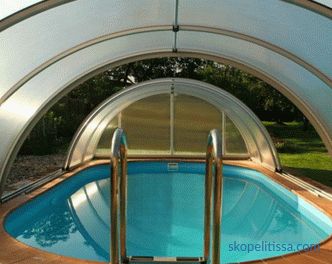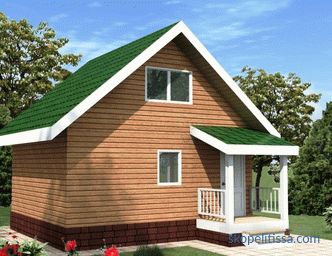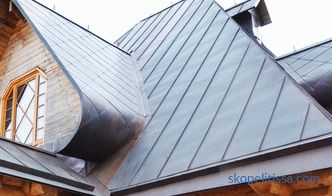There are several typical autonomous sewage schemes for a private house, country cottage or summer house. The choice of a particular option depends on many factors - from the seasonality of living and ending budget constraints. But the plastic capacity for sewage is present in most schemes.
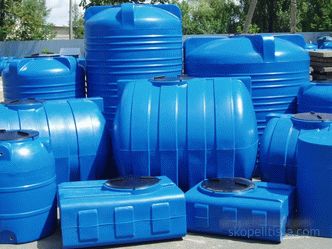
Depending on the capacity of the septic tank and the size of the capacity for sewage for a private house is selected
The advantages of plastic in comparison with other materials
Before the advent of plastic, other materials were used in the construction of sewage systems.
At the household level, pipes from asbestos cement, ceramics and cast iron were used to transport wastewater to the outer part of the sewage system. Asbestos cement material is brittle and has a low life in conditions of constant exposure to moisture (soil and internal). Sewer pipes made of ceramics are slightly stronger and last longer, but more expensive and more difficult to install. Cast iron pipes are expensive, but the worst thing is that at small angles of inclination they are prone to siltation, and when sealing is lost, the external sewage system loses its ability to clean itself, which leads to difficult removable blockages. Plastic pipes do not have these disadvantages.
Wells from reinforced concrete rings, bricks or solid concrete were usually installed to collect and partially process wastewater. Sometimes welded tanks made of steel sheet were used as a sewage tank. But all of these materials have flaws that plastic does not have.
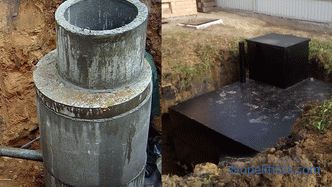
Concrete and metal septic tanks - significantly lose plastic performance.
A storage tank for sewage collected from reinforced concrete rings is still relevant. Strong, reliable and durable material fully complies with the requirements that apply to it. Provided that the manufacturer produces rings without violating the technology. Concrete material "capricious" - poor-quality ingredients (for example, expired cement, quarry sand mixed with clay) or savings on additives can significantly reduce the service life of the sewer well. The most "weak" link - the joints of the rings between themselves and with the bottom. And so that they remain airtight, it is necessary to carry out reliable waterproofing. And the main drawback - the cumulative capacity or septic tank of reinforced concrete rings is expensive, even in the case when the volume of wastewater is small.
A cumulative tank made of brick is not even considered at all as a cesspool. High hygroscopicity of the material, even under the condition of external waterproofing with roll materials, leads to rapid destruction and loss of tightness.
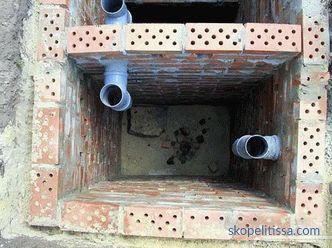
A brick septic tank is a lot of samostroya - impractical and inefficient, in comparison with a plastic container for sewage of a country house
You can find contacts of construction companies that offer the service of installation and design of sewage and water supply. Directly to communicate with representatives, you can visit the exhibition of houses "Low-rise Country".
Capacity from monolithic concrete on the duration of production and cost is akin to a small capital basin without finishing. Such a structure is then very difficult to dismantle if it becomes necessary to upgrade the autonomous sewage system or redevelop the site.
A reservoir of ordinary steel in a high humidity and aggressive environment will not last long, but costs more than plastic. And to use a stainless steel container is expensive and impractical.
The plastic container for the septic tank and the waste collector does not have the above disadvantages. Its advantages:
-
reasonable price;
-
inertness to any kind of domestic waste;
-
absolute tightness;
-
environmental safety;
-
high bending and tear strength;
-
small weight (simplifies transportation and installation);
-
long service life.
The only drawback is the need for rigid fixation of the container in the pit (for example, to the concrete slab at the base) and taking measures to reduce the effects of heaving forces. This should be done so that the container does not "float" to the surface.
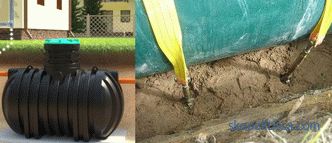
The plastic septic tank is fixed on the concrete slab or on reliable stretch marks
Only peatlands and the humus (fertile) layer have low density (1150-1200 kg / m 3 ), and the lightest loam and sandy loam (1600-1700 kg / m 3 ) are much heavier than a plastic tank with drains. Therefore, heaving forces will tend to push it to the surface.
Types of sewage tanks
There are three basic schemes for building an autonomous sewage system. In each of them, the plastic container performs its task and is distinguished by its internal structure.
Cumulative capacity
By function, this is a typical cumulative sewage system. Refers to the simplest and most affordable scheme. The tank has no internal partitions, and its task is to collect household wastewater for subsequent pumping by a sewage disposal vehicle.
Inside, only natural processes of waste decomposition take place without fractionation and wastewater treatment. The frequency of call of the vacuum trucks depends on the intensity of operation, and this is the main drawback that determines the scope of use - cottages, small country houses for seasonal living.
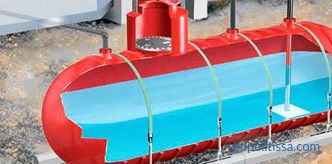
In the cumulative septic tank, wastewater is simply collected, which is then pumped out by an after-collecting machine
It might be interesting! In the article on the following link read about the sewer of concrete rings.
Anaerobic septic tank
This is a more advanced sewage system. Within the limits of the tank, wastewater is cleaned from harmful substances by 60-75%. The internal volume of the septic tank is divided into two or three sections "with overflow" in the upper part of the partition.
In the two-chamber septic tank in the first section, waste accumulates, their separation under the action of gravity into fractions - solid particles settle in the form of "sludge". Already here, at the first stage, the "fermentation" of waste begins, the displacement of oxygen from the reservoir and the accumulation of anaerobic bacteria. Then, after filling the section, the “clarified” drains are poured into the second chamber, where they are further cleaned.
In a three-chamber septic tank, the second section performs the same functions as the first, but with deeper separation and "clarification." But the three-stage cleaning is not enough to discharge waste into the ground or use it for technical needs - they must be passed through filtration fields, wells or infiltrators, in which additional treatment takes place under the influence of aerobic saprophyte bacteria.
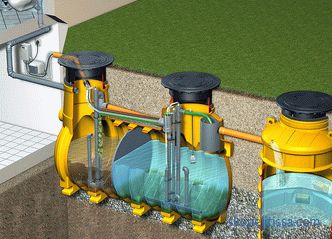
Two-chamber septic tank with additional treatment of wastewater in the filtration well
Biological treatment station
It is a three-chamber tank under septic tank, in which the first two compartments are used to separate wastewater and cleaning with anaerobic bacteria, and in the third (aeration tank), the purification is carried out using aerobic microorganisms. At the outlet of the tank, the purity of the treated effluent almost reaches the water level (95-98%) - they can be dumped into the ground or used to irrigate the area.
The main condition for the operation of an aerobic local cleaning system is forced air supply. With a lack of oxygen, aerobic microorganisms "work" inefficiently (partially die), which leads to loss of performance of the septic tank and insufficient "cleanliness" of the treated effluent.
Disadvantages - the volatility of the sewage system, restrictions on the composition of detergents and cleaning products for the kitchen and laundry (anions and phosphates kill aerobic bacteria).
Note! The described schemes of anaerobic and aerobic septic tanks are conditional. They may consist of not one, but two or three containers. But even in these cases, technical solutions at the level “chose a finished model, ordered, brought and installed” use plastic containers.
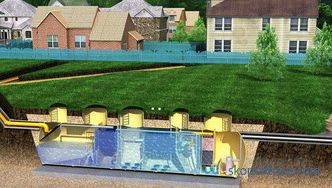
To reduce costs, you can order a large bio-cleaning station by collecting
Tanks for storm sewers and collecting treated wastewater
The difference of this type of tanks is the presence of several "pads" for cutting the receiving holes for pipes of different diameters. Usually it is a vertically oriented cylinder in the form of a "well" with additional stiffening rings on the body.
Plastic wells are used for different purposes:
-
drainage in storm sewers and drainage systems;
-
collection of sedimentary water and treated drains for irrigation;
-
use as a compact storage tank for sewage in the country.
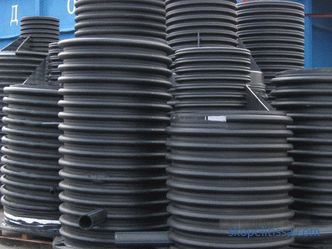
Plastic tanks for storm sewers or wells
Features of installation and operation of sewage tanks
When choosing a place for the installation of a tank, it is necessary to take into account the gravity of drainage - if the site is located on a slope, it should be located below the level of the house.
The bottom of the excavation should be smooth and durable, exclude the possibility of displacement of the container so as not to break the tightness of the connection to the sewer pipe.
For anchoring the tank, a reinforced concrete slab laid at the bottom of the pit with an obligatory cushion of rubble and sand is used.
In order to reduce the pusher force of the heaving, the pit is dug out more than the dimensions of the tank, and the sinuses are filled with a mixture of sand and excavated soil or sand and rubble.
The method of installing the storage tank for sewage is shown in the following video:
For pumping waste water from the storage sewer, cleaning the first An anaerobic or aerobic septic tank must be provided with an access road and a platform at such a distance so that the cesspool machine hose reaches the bottom of the tank.
It may be interesting! In the article on the following link read about the well for storm sewers.
Conclusion
When choosing a type of autonomous sewage system, it is necessary to take into account many aspects of both an objective and a subjective nature. The geological features of the site and its size, regulatory restrictions on the location relative to the house and water intake, productivity and frequency of maintenance, optimization of the project budget, taking into account seasonality or the possibility of separating the waste into black and gray, competent installation and arrangement of the adjacent territory - these criteria are enough to entrust work professionals.
